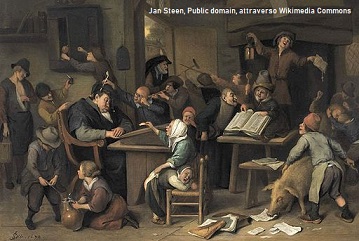Online Teaching of Chinese as a Second Language in an Emergency Situation: Methods and Findings
DOI:
https://doi.org/10.54103/2035-7680/17880Parole chiave:
emergency remote teaching; Covid-19; Chinese language teaching; active language learning; blended learning; flipped classroomAbstract
The purpose of this study was to identify problems teaching Chinese as a second language during the unexpected sudden lockdown in 2020 and then to propose strategies for similar future situations and better ways of planning remote teaching programs. The Covid-19 lockdown caused courses at Italian universities that are normally carried out face-to-face to be moved online. This affected language courses particularly severely. This article is focused on the experiences of staff and students involved in three Chinese language courses at two state universities in northern Italy. Background literature about online teaching is analyzed first, then the online teaching methods and tools that were used in the emergency are described and student survey results are assessed. The results are used to identify the strengths and weaknesses of the emergency online teaching provision. The possibility of using self-learning material and watching video-lessons was appreciated, but one of the main drawbacks was the lack of oral and written interaction. Actions for future development are proposed here. These include using asynchronous and synchronous tools to promote active language learning and interaction. An innovative proposal for a long-term teaching program is the flipped classroom, which would allow students to undertake self-learning at home but with a focus on interactions and practical activities during face-to-face classes.
Metriche
Riferimenti bibliografici
Balboni, Paolo. Le sfide di Babele. Insegnare le lingue nelle società complesse. UTET, 2006.
Bloom, Benjamin. Taxonomy of Educational Objectives Handbook. Cognitive Domains. David McKay, 1956.
Burgerova, Jana, and Ivana Cimermanova. “Creating a Sense of Presence in Online Learning Environment.” DIVAI 2014: The 10th International Scientific Conference in Distance Learning in Applied Informatics, 2014, pp. 275-284.
Capponi, Massimo. “Costruzione della conoscenza e nuove tecnologie.” E-learning. Aspetti pedagogici e didattici, edited by Floriana Falcinelli, Morlacchi, 2005, pp. 85-101.
Cecchinato, Graziano, and Romina Papa. Flipped classroom. Un nuovo modo di insegnare e apprendere. UTET Università, 2016.
Chen Ken. “汉语国际教育慕课平台建设的现状及思考——以Coursera平台上的课程为例 Hanyu guoji jiaoyu muke pingtai jianshe de xianzhuang ji sikao – yi Coursera pingtai shang de kecheng wei li (The Contrastive Analysis on MOOCs of Chinese as a Second Language——Take the Courses on Coursera Platform for Example).” Journal of Mudanjiang University, 2018, vol. 27, no. 7, pp. 121-125.
Cui Yonghua. 对外汉语,教学设计导论 Duiwai hanyu, jiaoxue sheji daolun (Cinese L2, introduzione all’organizzazione della didattica). Beijing Language and Culture University press, 2008.
Falcinelli, Floriana. E-learning. Aspetti pedagogici e didattici. Morlacchi, 2005.
Harasim, Linda. Learning theory and online technologies. Routledge/Taylor & Francis, 2012.
Hua Lu. “Construction of SPOC-based Learning Model and Its Application in Linguistics Teaching.” iJET, 2018, vol. 13, no. 2, pp. 157-169.
Kaplan, Andreas M., and Michael Haenlein. “Higher Education and the Digital Revolution. About MOOCs, SPOCs, Social Media, and the Cookie Monster.” Business Horizons, 2016, vol. 59, pp. 441-450.
Laici, Chiara. “Le figure professionali dell’e-learning.” E-learning. Aspetti pedagogici e didattici, edited by Floriana Falcinelli, Morlacchi, 2005, pp. 19-63.
Liang Zhihua. “Research on College English Flipped Classroom Teaching Mode Based On Mooc.” 3rd International Conference on Advancement of the Theory and Practices in Education (ICATPE 2019), 2019, pp. 1098-1101.
Lin Chin-Hsi, and Zhang Yining. “慕课与对外汉语教学 Muke yu duiwai hanyu jiaoxue (MOOCs and Chinese Language Education).” Journal of Technology and Chinese Language Teaching, Jan. 2014, vol. 5, no. 2, pp. 49-65.
Maglioni, Maurizio, and Fabio Biscaro. La classe capovolta. Innovare la didattica con la flipped classroom, Erickson, 2014.
Muñoz Gonzàlez, et al. “Instructional Design in Online Education: a Systemic Approach.” European Journal of Education, 2020, vol. 2, no. 3, pp. 64-73.
Panagiotidis, Panos. “MOOCs for Language Learning. Reality and Prospects.” SITE 2019, 2019, pp. 286-292.
Payne, Scott, and Paul Whitney. “Developing L2 Oral Proficiency through Synchronous CMC: Output, Working Memory, and Interlanguage Development.” CALICO Journal, 2002, vol. 20, no. 1, pp. 7-32.
Piras, Valeria, Maria Cecilia Reyes, and Guglielmo Trentin. Come disegnare un corso online. Criteri di progettazione didattica e della comunicazione. Franco Angeli, 2020.
Prunuske, Amy et al. “Using Online Lectures to Make Time for Active Learning.” Genetics, 2012, vol. 192, no. 1, pp. 67-72.
Siemens, George. “Connectivism: A Learning Theory for the Digital Age.” International Journal of Instructional Technology and Distance Learning, 2005, vol. 2, no. 1, jotamac.typepad.com/jotamacs_weblog/files/Connectivism.pdf. Accessed 22 Feb. 2022.
Skinner, Burrhus F. The Technology of Teaching. Appleton-Century Crofts, 1986.
Sun, Susan Yue Hua. “Online Language Teaching. The Pedagogical Challenges.” Knowledge Management & E-Learning: An International Journal, 2011, vol. 3, no. 3, pp. 428-447.
Szpunar, Karl, Samuel Moulton, and Daniel Schacter. “Mind wandering and education: from the classroom to online learning.” Frontiers in Psychology, 2013, vol. 4, pp. 1-7.
Thorndike, Edward L., et al. Adult Learning. Macmillan, 1928.
Tosato, Paolo, and Juliana Raffaghelli. “Risorse educative aperte e professione docente nell’era dell’accesso.” IJET – Italian Journal of Educational Technology. 2011, vol. 19, no. 2, pp. 88-95.
Trentin, Guglielmo. Didattica con e nella rete. Dall’emergenza all’uso ordinario. Franco Angeli 2020.
Vygotsky, Lev Semënovič. Thought and Language. MIT Press, 1986.
Wang Jue, and Joël Bellassen. “面向法语母语学习者的中文初阶慕课 Kit de contact en langue chinoise:设计,实施和发现 Mianxiang fayu muyu xuexizhe de zhongwen chujie muke Kit de contact en langue chinoise: sheji, shishi he faxian (Design, Implementation and Reflection on the Introductory Chinese MOOC Kit de contact en langue chinoise).” Journal of Modernization of Chinese language education, 2017, vol. 6, no. 1, pp. 31-41.
Weerasinghe, Thushani, et al. “Designing Online Learning Environments for Distance Learning.” International Journal of Instructional Technology and Distance Learning, 2009, vol. 6 no. 3, pp. 21-42.
Dowloads
Pubblicato
Come citare
Fascicolo
Sezione
Licenza

Questo articolo è soggetto a licenza Creative Commons Attribution-NonCommercial-NoDerivatives 3.0 International License.




